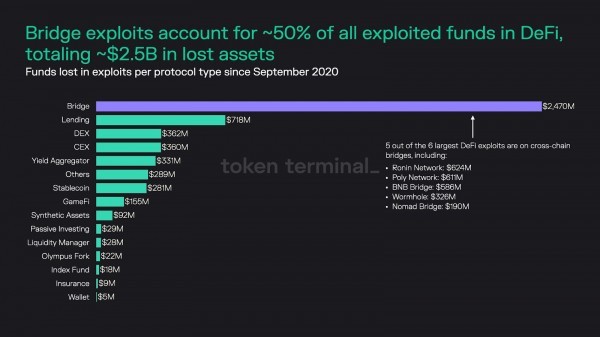As DeFi bleeds billions of dollars annually due to token bridge attacks, a new layer-2 solution seeks a solution from within the Bitcoin blockchain.

Own this piece of history

Decentralized finance (DeFi) saw a record inflow from centralized exchanges as crypto users flocked to self-custody solutions following the FTX collapse. Over 100,000 Bitcoin (BTC) left crypto exchanges so investors could avoid third-party custody. True to the “not your keys, not your coins” mantra of Bitcoin, DeFi solves a wide array of problems associated with centralized entities.
However, several reports indicate DeFi is not a fail-safe environment, as high-profile protocol exploits like Wormhole, Nomad and Ronin made headlines in 2022 for the wrong reasons.

Source: Token Terminal
DeFi exploiters particularly target cross-chain bridges. In fact, cross-chain bridge exploits account for more than half of all DeFi exploits since September 2020, with approximately $2.5 billion lost to these attacks. A Chainalysis report shows that token bridge attacks accounted for over 69% of the total amount of crypto stolen in 2022, a clear indication that bridge exploits are on the rise.
Why do cross-chain bridges fail?
Содержание статьи:
Since the DeFi ecosystem comprises multiple blockchains, transferring digital assets from one network to another requires specially designed protocols that work across different blockchains. Known as cross-chain bridges or token bridges, these protocols lock users’ deposited tokens from one chain into a contract, then issue the equivalent amount of assets to the same user in the receiving network.
For example, since the Bitcoin blockchain is not directly compatible with the Ethereum (ETH) blockchain, the DeFi ecosystem relies on workarounds like wrapped Bitcoin and token bridges to tap into the liquidity available in the Bitcoin ecosystem.
Most bridge protocols use central storage to back assets on the receiving blockchain, creating a target spot for hackers. The lack of developer expertise compared to the complex nature of creating a bridge that works across multiple networks causes security vulnerabilities, making cross-chain bridges the largest attack surface of the DeFi space.
How to make DeFi more robust
To make DeFi more resilient to exploits, a new approach removes this weak link between blockchains. Mintlayer is a layer-2 blockchain on the Bitcoin network that aims to connect its sidechain to the Bitcoin community with as little friction as possible. Users can build any type of existing DeFi application on Mintlayer without compromising the core fundamentals of security and decentralization that the Bitcoin community is built on.
Mintlayer aims to eliminate token bridges, the largest attack surface of DeFi, which costs users billions of dollars every year. Instead of wrapped tokens, users can exchange their BTC for tokens on the Mintlayer blockchain via atomic swaps. By not requiring any sort of cross-chain bridges, wrapped tokens or pegging mechanism to use Bitcoin on its blockchain, Mintlayer eliminates the risks associated with bridges and third-party custody.
Speaking about the launch of the Mintlayer blockchain, Mintlayer co-founder Enrico Rubboli said that it took over 18 months of hard work. He added:
“Mintlayer is home for projects willing to build on top of Bitcoin. We are thrilled by the quality and amount of responses regarding potential projects. People want the functionality of DeFi, but do not want to compromise the security and principles of Bitcoin.”
To enable users access to their BTC natively on the go, Mintlayer launched a mobile Bitcoin wallet, available on both Google Play and the App Store.
DeFi ecosystem focusing on Bitcoin
Aside from technical development, the team launched the Mintlayer Ecosystem Fund with the goal of building a Bitcoin-centric DeFi ecosystem. Projects can join incubator programs, accelerator programs and apply for grants, or apply for direct investment through the fund.
The collapse of major centralized organizations like Celsius, Terraform Labs and FTX triggered an exodus from centralized exchanges to decentralized finance and self-custody solutions in 2022.
If the DeFi ecosystem wants to keep this new user base, it needs to solve ongoing issues associated with the direct interaction between users and blockchains, starting with security — its most critical aspect. Coming back full circle, the answer may lie in making the path from Bitcoin to use in financial applications as short and straight as possible, with Mintlayer.
Learn more about Mintlayer
Disclaimer. Cointelegraph does not endorse any content or product on this page. While we aim at providing you with all important information that we could obtain, readers should do their own research before taking any actions related to the company and carry full responsibility for their decisions, nor can this article be considered as investment advice.
Source: cointelegraph.com


